The Pentagon’s new 30-year aircraft investment blueprint delivers to the Air Force this unmistakable message: The pace of USAF modernization will range from slow to extremely slow for many years.
The plan calls for a hiatus of at least 10 years in production of new strategic airlifters and long-range bombers. It envisions acquisition of fewer than a dozen tactical transports per year, on average. It calls for buys of F-35 fighters to build slowly and then level off at a rate that won’t meet required force levels until 2035.
The KC-X tanker will be the only large airplane purchase through 2025. Simple, unmanned aircraft will be increasingly prominent. For half of this decade, USAF’s airplane budget will be smaller than the Navy’s.
The “Aircraft Investment Plan, Fiscal Years 2011-2040” is DOD’s first-ever stab at mapping the armed services’ entire fixed wing airplane buys over a long period. It was submitted to Congress along with the Fiscal 2011 budget request.
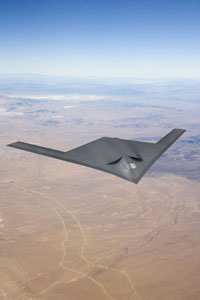 |
A Boeing concept for a new bomber. |
Will the work pace suffice to preserve the aircraft industrial base? Pentagon officials say yes. However, the plan is certain to become leaner in future years, as the services horse-trade over aviation roles and missions and planned procurement numbers come down. (It does not count rotary wing aircraft or upgrades to fixed wing aircraft.)
Congress, prompted by concerns that reductions in defense aviation orders could starve the aviation industrial base, called for the plan in 2008. The Defense Department failed to produce the plan in 2009, blaming the change in Administrations and uncertainties about major programs such as the F-22 fighter, KC-X tanker, and new bomber.
In this first AIP, the Air Force and Navy merely compared notes on their respective aircraft purchase plans; they did not compete for missions or eliminate much overlap. That will begin in earnest with the next version of the plan, which Congress directed be revised and resubmitted annually.
“We needed to start this with sort of a confidence-building approach,” explained Gen. Norton A. Schwartz, the USAF Chief of Staff. Schwartz believes the first run of the AIP was a success, but, asked if future versions will be more competitive and seek elimination of overlap, Schwartz said, “I’m certain that’s the case.”
The plan bears the signature of Defense Secretary Robert M. Gates. In it, he said the AIP had four main objectives:
“Meet the demand for persistent … intelligence, surveillance, and reconnaissance (ISR) capabilities,” provided mainly by unmanned or remotely piloted aircraft such as Global Hawk, Predator, and Reaper.
“Provide sufficient enabler capability and capacity,” such as a new aerial tanker, early warning aircraft, and tactical jammers such as the EA-18G Growler for the Navy.
“Acquire fifth generation fighter-attack aircraft” in the form of the F-35 fighter.
“Modernize long-range strike capabilities” by identifying “a replacement aircraft for the aging aircraft in the legacy bomber fleet.”
Answering Congress’ original question, Gates said, “This first aviation plan does not foresee major industrial base issues” in the near term. At a minimum, he went on, “there are no immediate concerns” about the strength of the American aviation industrial base, which he said would be sound for years to come. The Pentagon chief acknowledged, though, that “there are impacts to specific corporate interests in certain sectors.”
The early portion of the blueprint—the part covering years out to Fiscal 2015—mainly comprises the various “programs of record” already under way for the Fiscal 2011 budget, and in the Pentagon’s quarterly selected acquisition reports, which state costs and buying objectives for all major weapons procurement. So said Brig. Gen. Richard C. Johnston, USAF’s director of strategic planning, who led the Air Force’s AIP team.
Beyond 2015, the builders of the AIP relied on a notional three percent real growth in defense spending, as instructed by Gates.
“In the immediate future, I think our major programs are set,” Air Force Secretary Michael B. Donley said of the aviation plan at AFA’s Air Warfare Symposium in Orlando, Fla., earlier this year. New starts will “have to await an economic recovery” and will be based on “what level of resources will be provided to defense” in the next four to six years.
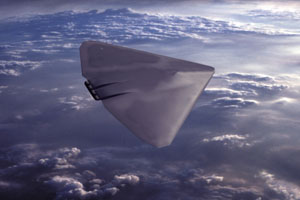 |
An artist’s conception of the new long-range bomber. (Illustration by Erik Simonsen)
|
Donley said the order for a 30-year plan from Congress was “a very ambitious request,” given that in a span of three decades, “we could see the defense budget go up and down three times, and we could see the strategic environment change once, twice, three times in significant ways affecting our security requirements. So, it is very hard putting together a 30-year aviation plan that one would actually build to.”
He said that the AIP was a useful exercise in confronting “what parts of our fleet may reach a certain age” beyond which they may not be relevant or sustainable, and to “think about how we will need to sequence our work … to accommodate different mission areas and platform requirements and capabilities.”
Given the long-term nature of the study, the Defense Department acknowledged that, within the 30 years, it will be necessary to recapitalize some aircraft now considered still brand-new. For example, the AIP says that, although this decade will see a large investment in “follow-on capabilities for the F-22 Raptor,” a successor aircraft, called F-X, “would be needed about 2025.”
SLEP for the C-17
Johnston said “economic realities” mean that the F-X would not wholly replace the F-22 in 2025, but “maybe that’s the first airplane on the ramp.” In assessing a replacement for the F-22 and eventually the F-35, the Pentagon will consider “both manned and unmanned options,” according to the report.
Air Combat Command is in the midst of an analysis of alternatives defining the general capabilities of an F-22 replacement, but it will not be done for a year. If it followed the pattern of the F-22, which took 20 years to develop and field, the F-22’s replacement might not be in service until 2030.
Intratheater lift—in the form of the C-130J and C-27—peaks at 16 airframes in Fiscal 2011 and declines from there, and drops to just two per year in Fiscal 2013 and Fiscal 2014. The US will purchase aircraft up to the economical build rate; foreign orders will claim a larger share of tactical transports produced in some years.
The Air Force has said that it already has more than the 300 strategic airlifters it needs, and all of the fleet—relatively new C-17s and heavily upgraded C-5Ms—will be sound well into the 2040s, so no new big airlifters are planned for more than a decade. Development of a new strategic airlifter, to replace the C-5, would get started with modest funding beginning in 2016. Although the plan does not delve into modifications, Air Force officials speculated that the C-17 fleet would likely undergo a significant service life extension program starting in the late 2010s.
The overall size of the aircraft fleet operated by the Defense Department (including aircraft already in service) will bottom out at 5,300 in Fiscal 2017. Three years later, it will peak at 5,500 airframes, if aggressive production of the F-35 and remotely piloted aircraft is sustained.
During the 2020s, the fighter inventory “will decline slightly (a roughly 10 percent decrease) … while aircraft in the multirole unmanned aerial system category will more than quadruple,” the AIP states. Of course, these levels are subject to change “in response to operational needs, industrial base considerations, and fiscal constraints.”
The Air Force-Navy-Marine Corps fighter inventory will decline steadily from 3,264 airframes in Fiscal 2011 to 2,883 machines in Fiscal 2018, at which point the fleet begins a slow increase. Over the same period, multirole remotely piloted aircraft in the MQ-9 Reaper class will increase from 72 aircraft in Fiscal 2011 to 476 airframes in Fiscal 2020. The Air Force would buy approximately 260 of these, and production across all services for Reaper-class aircraft would remain steady at about 48 per year for most of the 2010s. Without explanation, the Reaper-class category zooms to 60 produced in 2018, followed by a drop to 16 in ’19 and 24 in ’20.
The Air Force will not purchase any more MQ-1 Predator vehicles, as the Reaper offers more endurance and a larger payload—about equivalent to the F-16 fighter—and can carry a wider variety of weapons.
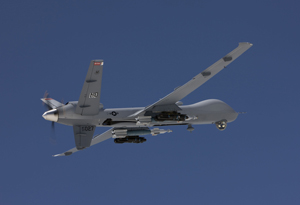 |
An MQ-9 Reaper armed with laser guided bombs and missiles. The Reaper can carry a payload roughly equivalent to an F-16 fighter. (Photo by Jim Haseltine)
|
The Air Force will explore a “potential follow-on” to the Reaper in the next decade even as it backfits previously built aircraft with electronic attack capabilities. The MQ-9 will be complemented by the MC-12W manned ISR platform.
The AIP notes that, although some see remotely piloted or unmanned aircraft as a cheap replacement for manned aircraft, “the cost (both in dollars and personnel) of expanding unmanned capacity and capability is not insignificant.” The Pentagon has tried to balance unmanned vs. manned “with a view toward providing the resources necessary to meet the demand for persistent, unmanned ISR/strike assets”—read, in the current fight—but “will continue to adapt the mix of unmanned and manned systems as security needs evolve.”
Not an Overarching Roadmap
In today’s dollars, “total aviation investments will amount to $268 billion” over the decade 2010 to 2020, according to the AIP.
The Navy will enjoy the larger share of aircraft dollars from Fiscal 2011 until Fiscal 2016, when the Air Force catches up and both services are spending roughly $15 billion a year on airplanes. In Fiscal 2011, the disparity is $4 billion in the Navy’s favor, driven largely by continued production of the F/A-18E/F Super Hornet and its variant, the electronic attack EA-18G Growler.
By 2020, about half the Navy’s aircraft money will go toward development and production of a stealthy, long endurance unmanned aircraft in the same size class as the F-35. The Marine Corps will also seek an RPA in the Reaper class during the same period. By 2020, the Navy will be spending about $7 billion a year on unmanned aircraft, compared to the Air Force’s investment of less than $1 billion in that year.
The Air Force plans no replacements for its E-3 AWACS, RC-135 Rivet Joint, or E-8 Joint STARS aircraft until the 2040s. In the meantime, most of its purchases of ISR aircraft will focus on the unmanned RQ-4 Global Hawk. The Air Force expects to buy about 77 Global Hawks, and the Navy about 60 almost identical aircraft under the Broad Area Maritime Surveillance program.
The Air Force will consider unmanned replacements for its large ISR aircraft if the technology will permit. In the 2010s, however, the Navy will buy the P-8A Poseidon manned surveillance aircraft (based on the Boeing 737) and newly built versions of the E-2D Hawkeye carrier-capable AWACS aircraft.
Johnston said that the airframe selected to be the KC-X tanker might conceivably be the platform for a replacement of the E-3 AWACS, RC-135 Rivet Joint, and E-8 Joint STARS, but because replacement of those airplanes will occur in, as the AIP says, “the far term,” specifics about successors for those airframes aren’t known yet.
“We wanted to make sure that section was in there because we recognize that those platforms will start to reach the end of their service lives. … But as far as what platform and exactly when, that’s something we … don’t have the knowledge on,” Johnston said.
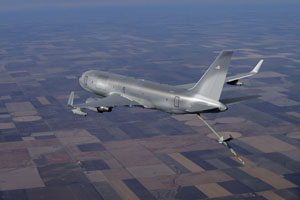 |
Boeing’s entry in the tanker competition, the NewGen tanker. (Boeing illustration) |
The AIP was not run through operational combat simulations or models, per se, according to Col. Stephen Walters, chief of USAF’s long-range planning division.
However, “that’s something that we are constantly doing as we change assumptions,” Walters said. “We’ve done those kinds of studies in the past, and that information that we have influences very heavily what exists in the President’s budget.” He noted that the AIP was intended to inform Congress about new aircraft construction; it is not meant to be an overarching roadmap of aviation because it doesn’t include upgraded older aircraft or munitions.
Walters noted that the AIP was based on three percent real growth in the budget in the years following Fiscal 2015—the year the current Future Years Defense Program expires—and did not attempt to predict any “significant dips” or boosts in defense spending.
According to the AIP, the Air Force won’t start spending upward of $1 billion a year on a new long-range strike aircraft until 2015, and only reaches $3 billion a year by Fiscal 2020. That was the midline of a level as high as $4 billion that year or as low as $2 billion, since the outcomes of ongoing studies regarding long-range strike are not yet known. Gates and his many lieutenants have said they are seeking a portfolio of long-range strike capabilities to include manned and unmanned, penetrating, and standoff capabilities.
In long-range strike, the “exact investment profile for FY 2016-2020 will be informed by study results,” according to the AIP. If spending is required above a notional three percent real growth above inflation, that “would entail making commensurate reductions in other programs.”
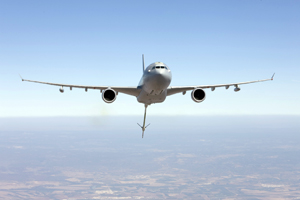 |
The tanker offering from EADS, the A330 Multirole Tanker Transport. (EADS photo)
|
The KC-X tanker program, the Air Force’s highest priority, will produce 109 new airplanes by 2020, at an investment of roughly $3.7 billion a year from Fiscal 2014 through 2020. The program is to produce 179 aircraft before the Air Force seeks a KC-Y and KC-Z, which would replace the KC-10 fleet.
Even with new airplanes coming on, though, the tanker inventory would slide through most of this decade, as KC-135s are retired faster than KC-Xs will come into service. From 551 aircraft in Fiscal 2012, the tanker fleet will slip to 531 aircraft by Fiscal 2018. It begins to rebound in 2020, with 534 airplanes. The tanker inventory counts Air Force strategic tankers and special operations tankers as well as Marine Corps KC-130s.
Capability Redundancies
Brig. Gen. Derek P. Rydholm, Johnston’s deputy, said the Air Force was satisfied that all participants in the AIP “had a good chance to look at this before it became a final product,” and that the Pentagon’s Cost Assessment and Program Evaluation shop (previously known as Program Analysis and Evaluation) “did a good job of ensuring that they incorporated, to the maximum extent possible, everything that we gave them.”
Schwartz said that although there was no head-to-head competition for aviation budget share in the first round of the AIP, the two services did recognize that they were developing redundant capabilities regarding the RQ-4 Global Hawk unmanned reconnaissance and surveillance aircraft. As a result, they will make efforts to consolidate RQ-4 production, training, and support facilities, sharing where possible to reduce costs. Unique capabilities developed for one can be used by the other. The Air Force, for example, will benefit from anti-icing features developed for the Navy’s version of the airplane.
Referring to Chief of Naval Operations Adm. Gary Roughead, Schwartz said, “Gary and I are committed to not having more differences between these platforms than is truly necessary.”
He also pointed out that, partly as a result of the discussions, the Navy has decided it doesn’t need to operate remotely piloted aircraft in the class of the Predator and Reaper, and will “migrate that equipment to us because they don’t want to operate in that space.”
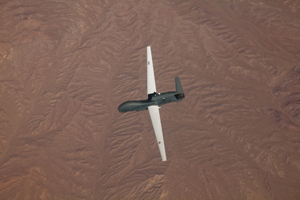 |
USAF’s Global Hawk performs a mission high over a mountain range. The intelligence- surveillance-reconnaissance aircraft can operate above 60,000 feet. (Northrop Grumman photo)
|
In future years, Schwartz said he and Roughead will seek more ways to economize by sharing aircraft types, training, and support facilities where it makes sense to do so.
Although the Navy has had a shipbuilding plan for many years, and “they’ve been reasonably successful [with] that,” there has never been an aircraft plan before, and Rydholm said the AIP may evolve into something like the Navy’s shipbuilding scheme. That plan gets regular attention from Congress, which has shown consistent concern that shipbuilding capabilities not atrophy in the US.
“I think it will evolve to the point where we’re … looking holistically at where we might want to go” across the services with aircraft production, Rydholm said, “but I don’t think we’re there yet.”
The AIP will undoubtedly be in constant revision, Gates said in his summary.
“A changing strategic environment will likely require continuous adjustments in aviation investments. National security requirements could arise in the 2020s and 2030s that cannot be foreseen today, just as the heavy reliance on unmanned vehicles could not have been anticipated 10 years ago.” Nevertheless, the AIP has “immense complexity relative to the more mature shipbuilding plan,” because it covers three services as well as technology with “a much shorter technological half-life” than ships.